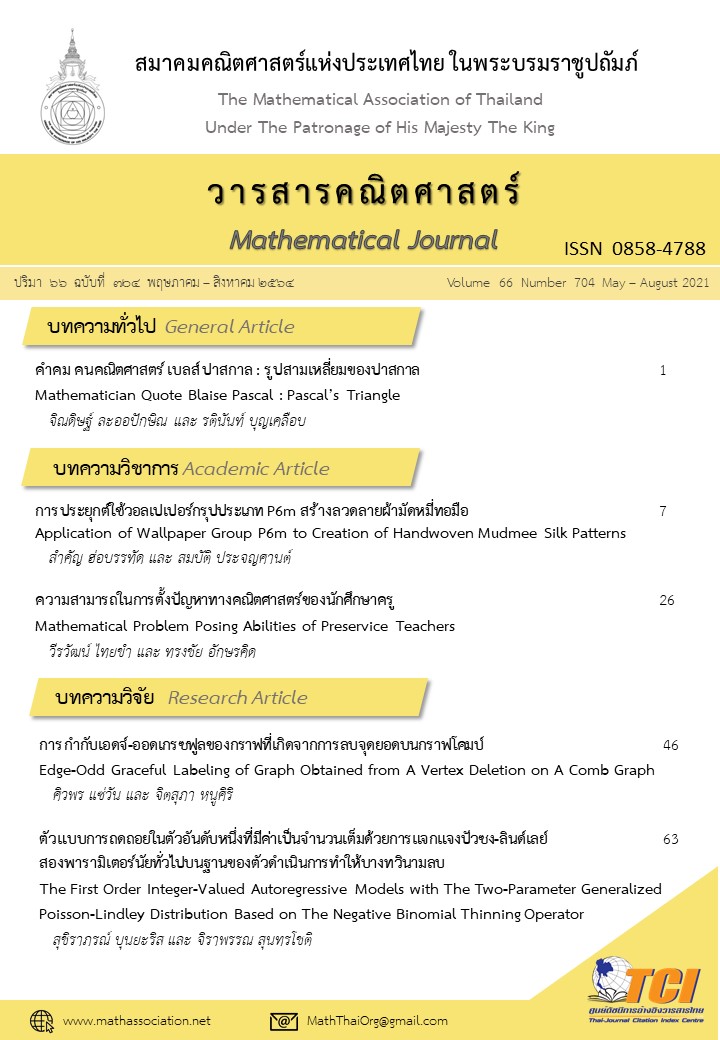Mathematical Problem Posing Abilities of Preservice Teachers
Main Article Content
Abstract
Mathematical problem posing is another important ability that should be promoted to learners at all levels of education. Especially preservice teachers, if they have this ability, they can pose problems that will support mathematical learning for students in the future. From studying and collecting research on mathematical problem posing ability of preservice teachers can be divided into 5 categories which are (1) the ability to pose problems according to the techniques or strategies for problem posing (2) the ability to pose problems in accordance with the nature of the conditions or situations given (3) the ability to pose problems using the strategy to solve the given problems (4) the ability to pose problems integrated and connected to real contexts and (5) the ability to pose mathematical problems suitable for students. The author presents details and examples of the ability to pose mathematical problems in each category and hopes that this article can be a guideline to further develop the ability to pose mathematical problems for preservice teachers.
Article Details
References
Brown, S. I., and Walter, M. I. (2005). The Art of Problem Posing. Psychology Press.
Crespo, S. (2003). Learning to Pose Mathematical Problems: Exploring Changes in Preservice Teachers' Practices. Educational Studies in Mathematics, 52 (3), p. 243 - 270.
Crespo, S., and Sinclair, N. (2008). What Makes A Problem Mathematically Interesting? Inviting Prospective Teachers to Pose Better Problems. Journal of Mathematics Teacher Education, 11 (5), p. 395 - 415.
Grundmeier, T. A. (2015). Developing The Problem-Posing Abilities of Prospective Elementary and Middle School Teachers. Mathematical Problem Posing (p. 411 - 431). Springer, New York.
Kılıç, Ç. (2017). A New Problem-Posing Approach Based on Problem-Solving Strategy: Analyzing Pre-service Primary School Teachers’ Performance. Educational Sciences: Theory & Practice, 17 (3), p. 771 – 789.
Lappan, G. (1991). Professional Standards for Teaching Mathematics. Reston (Virginia): National Council for Teachers of Mathematics. Houston.
Leavy, A., and Hourigan, M. (2020). Posing Mathematically Worthwhile Problems: Developing The Problem-Posing Skills of Prospective Teachers. Journal of Mathematics Teacher Education, 23, p. 1 - 21.
Lee, Y., Capraro, R. M., and Capraro, M. M. (2018). Mathematics Teachers’ Subject Matter Knowledge and Pedagogical Content Knowledge in Problem Posing. International Electronic Journal of Mathematics Education, 13 (2), p. 75 - 90.
Nicol, C., and Bragg, L. (2009). Designing Problems: What Kinds of Open-Ended Problems Do Preservice Teachers Pose?. Proceedings of 33rd Annual Meeting of The International Group for The Psychology of Mathematics Education (p. 225 - 232). Thessaloniki, Greece.
Rellensmann, J., and Schukajlow, S. (2017). Does Students’ Interest in A Mathematical Problem Depend on The Problem’s Connection to Reality? An Analysis of Students’ Interest and Pre-service Teachers’ Judgments of Students’ Interest in Problems With and Without A Connection to Reality. ZDM – Mathematics Education, 49 (3), p. 367 - 378.
Silber, S., and Cai, J. (2017). Pre-service Teachers' Free and Structured Mathematical Problem Posing. International Journal of Mathematical Education in Science and Technology, 48 (2), p. 163 - 184.
Silver, E. A. (1994). On Mathematical Problem Posing. For The Learning of Mathematics, 14 (1), p. 19 - 28.
Unver, S. K., Hidiroglu, C. N., Dede, A. T., and Guzel, E. B. (2018). Factors Revealed while Posing Mathematical Modelling Problems by Mathematics Student Teachers. European Journal of Educational Research, 7 (4), p. 941 - 952.


